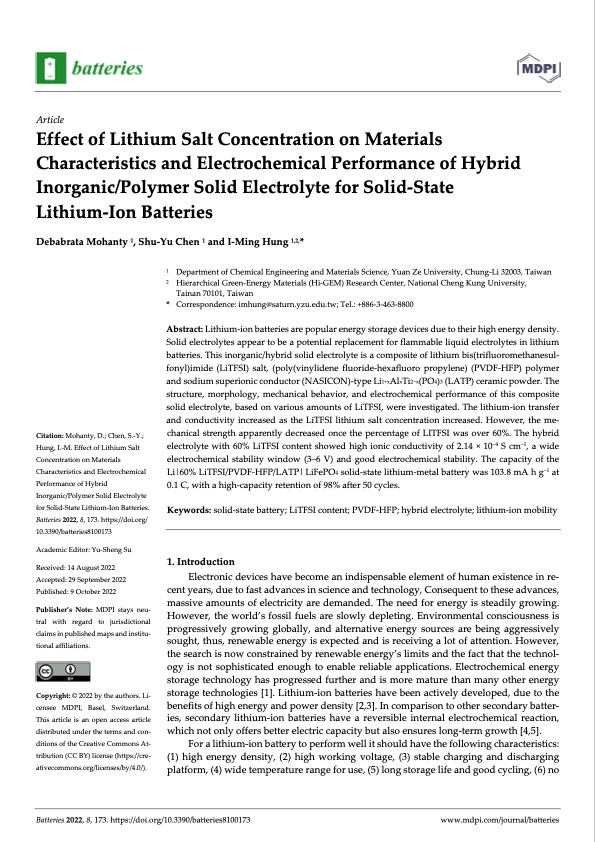
PDF Publication Title:
Text from PDF Page: 001
Article Effect of Lithium Salt Concentration on Materials Characteristics and Electrochemical Performance of Hybrid Inorganic/Polymer Solid Electrolyte for Solid-State Lithium-Ion Batteries Debabrata Mohanty 1, Shu-Yu Chen 1 and I-Ming Hung 1,2,* Citation: Mohanty, D.; Chen, S.-Y.; Hung, I.-M. Effect of Lithium Salt Concentration on Materials Characteristics and Electrochemical Performance of Hybrid Inorganic/Polymer Solid Electrolyte for Solid-State Lithium-Ion Batteries. Batteries 2022, 8, 173. https://doi.org/ 10.3390/batteries8100173 Academic Editor: Yu-Sheng Su Received: 14 August 2022 Accepted: 29 September 2022 Published: 9 October 2022 Publisher’s Note: MDPI stays neu- tral with regard to jurisdictional claims in published maps and institu- tional affiliations. Copyright: © 2022 by the authors. Li- censee MDPI, Basel, Switzerland. This article is an open access article distributed under the terms and con- ditions of the Creative Commons At- tribution (CC BY) license (https://cre- ativecommons.org/licenses/by/4.0/). 1 Department of Chemical Engineering and Materials Science, Yuan Ze University, Chung-Li 32003, Taiwan 2 Hierarchical Green-Energy Materials (Hi-GEM) Research Center, National Cheng Kung University, Tainan 70101, Taiwan * Correspondence: imhung@saturn.yzu.edu.tw; Tel.: +886-3-463-8800 Abstract: Lithium-ion batteries are popular energy storage devices due to their high energy density. Solid electrolytes appear to be a potential replacement for flammable liquid electrolytes in lithium batteries. This inorganic/hybrid solid electrolyte is a composite of lithium bis(trifluoromethanesul- fonyl)imide (LiTFSI) salt, (poly(vinylidene fluoride-hexafluoro propylene) (PVDF-HFP) polymer and sodium superionic conductor (NASICON)-type Li1+xAlxTi2−x(PO4)3 (LATP) ceramic powder. The structure, morphology, mechanical behavior, and electrochemical performance of this composite solid electrolyte, based on various amounts of LiTFSI, were investigated. The lithium-ion transfer and conductivity increased as the LiTFSI lithium salt concentration increased. However, the me- chanical strength apparently decreased once the percentage of LITFSI was over 60%. The hybrid electrolyte with 60% LiTFSI content showed high ionic conductivity of 2.14 × 10−4 S cm−1, a wide electrochemical stability window (3–6 V) and good electrochemical stability. The Li|60% LiTFSI Keywords: solid-state battery; LiTFSI content; PVDF-HFP; hybrid electrolyte; lithium-ion mobility 1. Introduction Electronic devices have become an indispensable element of human existence in re- cent years, due to fast advances in science and technology, Consequent to these advances, massive amounts of electricity are demanded. The need for energy is steadily growing. However, the world’s fossil fuels are slowly depleting. Environmental consciousness is progressively growing globally, and alternative energy sources are being aggressively sought, thus, renewable energy is expected and is receiving a lot of attention. However, the search is now constrained by renewable energy’s limits and the fact that the technol- ogy is not sophisticated enough to enable reliable applications. Electrochemical energy storage technology has progressed further and is more mature than many other energy storage technologies [1]. Lithium-ion batteries have been actively developed, due to the benefits of high energy and power density [2,3]. In comparison to other secondary batter- ies, secondary lithium-ion batteries have a reversible internal electrochemical reaction, which not only offers better electric capacity but also ensures long-term growth [4,5]. For a lithium-ion battery to perform well it should have the following characteristics: (1) high energy density, (2) high working voltage, (3) stable charging and discharging platform, (4) wide temperature range for use, (5) long storage life and good cycling, (6) no /PVDF-HFP/LATP| Batteries 2022, 8, 173. https://doi.org/10.3390/batteries8100173 www.mdpi.com/journal/batteries LiFePO4 solid-state lithium-metal battery was 103.8 mA h g−1 at capacity of the 0.1 C, with a high-capacity retention of 98% after 50 cycles.PDF Image | Lithium Salt Concentration on Materials

PDF Search Title:
Lithium Salt Concentration on MaterialsOriginal File Name Searched:
batteries-08-00173.pdfDIY PDF Search: Google It | Yahoo | Bing
Product and Development Focus for Salgenx
Redox Flow Battery Technology: With the advent of the new USA tax credits for producing and selling batteries ($35/kW) we are focussing on a simple flow battery using shipping containers as the modular electrolyte storage units with tax credits up to $140,000 per system. Our main focus is on the salt battery. This battery can be used for both thermal and electrical storage applications. We call it the Cogeneration Battery or Cogen Battery. One project is converting salt (brine) based water conditioners to simultaneously produce power. In addition, there are many opportunities to extract Lithium from brine (salt lakes, groundwater, and producer water).Salt water or brine are huge sources for lithium. Most of the worlds lithium is acquired from a brine source. It's even in seawater in a low concentration. Brine is also a byproduct of huge powerplants, which can now use that as an electrolyte and a huge flow battery (which allows storage at the source).We welcome any business and equipment inquiries, as well as licensing our flow battery manufacturing.| CONTACT TEL: 608-238-6001 Email: greg@salgenx.com | RSS | AMP |